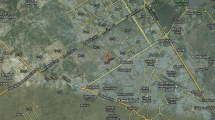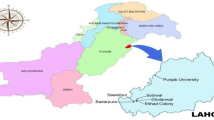Abstract
Increasing levels of pollution put plants under stress, leading to changes in their biochemical factors, which can be measured using the pollution tolerance index (APTI). APTI is a measure of environmental stress on flora, and it is calculated using four parameters (chlorophyll, ascorbic acid, relative water content, and pH). Earlier work in the same belt showed a positive correlation between stress and APTI but concentrated on woody trees only. This study was conducted in the Durgapur industrial belt, West Bengal, from August 2019 to February 2020. Eighteen plant species (herbs) were collected, assessed, and categorized as sensitive, intermediate, and tolerant based on their seasonal APTI values. Results showed that Solanum sisymbriifolium fell in the intermediate range in all three seasons. Persicaria sp. was identified as a tolerant species throughout and could be used to form a green belt. Persicaria orientalis was a sensitive species and can be used as an indicator of pollution.




Similar content being viewed by others
Availability of data and material
The data that support the findings of this study are available from the authors upon reasonable request.
Code availability
The codes that support the software run in this study are available from the authors upon reasonable request.
References
Agarwal, S. K. (1986). A new distributional function of foliar phenol concentration in the evaluation of plants for their air pollution tolerance index. Acta Ecologica, 8(2), 29–36.
Baker, N. R. (2008). Chlorophyll fluorescence: A probe of photosynthesis in vivo. The Annual Review of Plant Biology, 59, 89–113.
Bakiyaraj, R., & Ayyappan, D. (2014). Air pollution tolerance index of some terrestrial plants around an industrial area. International Journal of Modern Research and Reviews, 2(1), 1–7.
Balasubramanian, A., Hari Prasath, C. N., Gopalakrishnan, K., & Radhakrishnan, S. (2018). Air pollution tolerance index (APTI) assessment in tree species of Coimbatore urban city, Tamil Nadu, India. International Journal of Environment and Climate Change, 8(1), 27–38.
Banerjee, S., Palit, D., & Banerjee, A. (2016). Changing strategies of biochemical & physiological features of selected plant species on effect of air pollution in Eastern Steel City, Durgapur, India. International Journal of Current Microbiology and Applied Sciences, 5(9), 733–741.
Bhattacharya, T., Kriplani, L., & Chakraborty, S. (2013). Seasonal variation in air pollution tolerance index of various plant species of Baroda city. Universal Journal of Environmental Research and Technology, 3(2), 199–201.
Bilska, K., Wojciechowska, N., Alipour, S., & Kalemba, E. M. (2019). Ascorbic acid—the little-known antioxidant in woody plants. Antioxidants, 8(12), 645.
Bora, M., & Joshi, N. (2014). A study on variation in biochemical aspects of different tree species with tolerance and performance index. The Bioscan, 9(1), 59–63.
Das, S., & Prasad, P. (2010). Seasonal variation in air pollution tolerance indices and selection of plant species for industrial areas of Rourkela. Indian Journal of Environmental Protection, 30(12), 978–988.
Dwivedi, A. K., & Tripathi, B. D. (2007). Pollution tolerance and distribution pattern of plants in surrounding area of coal-fired industries. Journal of Environmental Biology, 28(2), 257–263.
Dwivedi, A. K., Tripathi, B. D., & Shashi. (2008). Effect of ambient air sulphur dioxide on sulphate accumulation on plants. Journal of Environmental Biology, 29(3), 377–379.
Hammer, Ø., Harper, D. A. T., & Ryan, P. D. (2001). PAST: Paleontological Statistics software package for education and data analysis. Palaeontologia Electronica, 4(1), 9.
Joshi, P. C., & Swami, A. (2009). Air pollution induced changes in the photosynthetic pigments of selected plant species. Journal of Environmental Biology, 30(2), 295–298.
Kaur, M., & Nagpal, A. K. (2017). Evaluation of air pollution tolerance index and anticipated performance index of plants and their application in development of green space along the urban areas. Environmental Science, Pollution and Research, 24, 18881–18895.
Li, F., **ea, Y., Zhanga, C., Chena, X., Song, B., Li, Y., Tanga, Y., & Hua, J. (2014). Increased density facilitates plant acclimation to drought stress in the emergent macrophyte Polygonum hydropiper. Ecological Engineering, 71, 66–70.
Liu, M., Liu, X., Li, M., Fang, M., & Chi, W. (2010). Neural-network model for estimating leaf chlorophyll concentration in rice under stress from heavy metals using four spectral indices. Biosystems Engineering, 106, 223–233.
Lorenz, A. J., Reynolds, R. W., & Stevens, S. J. W. (1936). Symp. Vitamin., Am. Chem. Soc., 92nd Meeting.
Mackinney, G. (1941). Absorption of light by chlorophyll solutions. The Journal of Biological Chemistry, 315–322.
Mafakheri, A., Siosemardeh, A., Bahramnejad, B., Struik, P. C., Sohrabi, Y. (2010). Effect of drought stress on yield, proline and chlorophyll contents in three chickpea cultivars. Australian Journal of Crop Science, 4(8).
Nayak, A., Madan, S., & Matta, G. (2018). Evaluation of Air Pollution Tolerance Index (APTI) and Anticipated Performance Index (API) of some plants species in Haridwar City. International Journal for Environmental Rehabilitation and Conservation, 9(1), 1–7.
Padmanavi, P., Cherukuri, J., & Reddy, M. A. (2013). Impact of air pollution on crops in the vicinity of a power plant: A case study. International Journal of Engineering, Research and Technology, 2(12), 3641–3651.
Pandey, D. D., Sinha, C. S., & Tiwari, M. G. (1991). Impact of coal dust pollution on biomass, chlorophyll and grain characteristics of rice. Journal of Biology, 3, 51–55.
Patel, A. M., & Kousar, H. (2011). Assessment of RWC, leaf extract pH, ascorbic acid and total chlorophyll of some plants species growing in Shivamoga. Plant Archives, 11, 935–939.
Radhapriya, P., Gopalakrishnan, A. N., Malini, P., & Ramachandran, A. (2012). Assessment of air pollution tolerance levels of selected plants around cement industry, Coimbatore, India. Journal of Environmental Biology, 33, 635–641.
Rai, P. K., Panda, L. L. S., & Chutia, B. M. (2014). Assessment of air pollution tolerance indices for certain roadside plants in Aizawl, Mizoram. India. the Ecoscan, 8(1–2), 33–39.
Rawal, D. S., Sijapati, J. S., Rana, N., & Pradhananga, T. M. (2001). Air pollution tolerance index of some tree species of Kathmandu Valley, Nepal. Journal of Science and Technology, 3, 119–122.
Ritchie, R. J. (2006). Consistent sets of spectrophotometric chlorophyll equations for acetone, methanol and ethanol solvents. Photosynthesis Research, 89, 27–41.
Sahu, C., & Sahu, S. K. (2015). Air pollution tolerance index (APTI), anticipated performance index (API), carbon sequestration and dust collection potential of Indian tree species – A review. International Journal of Emerging Research in Management & Technology, 4(11), 37–40.
Satpute, S. B., & Bhalerao, S. A. (2017). Assessment of air pollution tolerance index (APTI) and anticipated performance index (API) for designing green belt. Research Journal of Chemical and Environmental Sciences, 5(1), 86–94.
Sen, A., Khan, I., Kundu, D., Das, K., & Datta, J. K. (2017). Ecophysiological evaluation of tree species for biomonitoring of air quality and identification of air pollution-tolerant species. Environmental Monitoring and Assessment, 189, 262.
Sen, D. N., Bhandari, M. C. (1978). Ecological and water relation to two Citrullus spp. In: Althawadi, A.M. (Ed.). Indian arid zone. Environmental Physiology and Ecology of Plants, 203–228.
Sharma, I. B., Bhardwaj, S. K., Sharma, S., Nautiyal, R., Kaur, L., & Alam, N. M. (2019). Pollution tolerance assessment of temperate woody vegetation growing along the National Highway-5 in Himachal Pradesh. Environmental Monitoring and Assessment, 191, 177.
Singh, S. K., Rao, D. N. (1983). Evaluation of the plants for their tolerance to air pollution. Proceedings Symposium on Air Pollution control held at IIT, Delhi, 218–224.
Taibi, K., Taibi, F., Abderrahem, L. A., Ennajah, A., Belkhodja, M., & Mulet, J. M. (2016). Effect of salt stress on growth, chlorophyll content, lipid peroxidation and antioxidant defence systems in Phaseolus vulgaris L. South African Journal of Botany, 105, 306–312.
Thambavani, S. D., & Sabitha, M. A. (2011). Variation in air pollution tolerance index and anticipated performance index of plants near a sugar factory: Implications of landscape plant species selection of industrial areas. Journal of Research in Biology, 7, 494–502.
Thawale, P. R., Babu, S. S., Wakode, R. R., Singh, S. K., Kumar, S., & Juwarkar, A. A. (2011). Biochemical changes in plant leaves as a biomarker of pollution due to anthropogenic activity. Environmental Monitoring and Assessment, 177, 527–535.
WBPCB. (2019). Report on daily ambient air quality. West Bengal Pollution Control Board. Available online: http://www.wbpcb.gov.in/html/aaq_info.shtml
Wolken, J. J., Mellon, A. D., Greenblatt, C. L. (1955). Environmental factors affecting growth and chlorophyll synthesis in Euglena.* I. Physical and chemical. II. The effectiveness of the spectrum for chlorophyll synthesis. The Journal of Protozoology, 2(3), 89–96.
Acknowledgements
Author Sanchari Sarkar is grateful to Dr. Purushottam Pramanick, principal, Durgapur Government College, for the infrastructural support to carry out the work. The author is thankful to Dr. Rajeshree Sanyal for editing the paper. The author also thanks Dr. Rajib Biswas, assistant professor, Department of Conservation Biology, Durgapur Government College, for hel** in the identification of the plant species.
Funding
This study received financial aid to carry out the work from the Department of Higher Education, Science & Technology and Biotechnology, Govt. of West Bengal, India (Sanction Order No. 208(Sanc.)/ST/P/S&T/5G-17/2018 dated 20/02/2019).
Author information
Authors and Affiliations
Contributions
Conceptualization: Moitreyee Chakrabarty; methodology: Moitreyee Chakrabarty, Sanghamitra Sanyal; formal analysis and investigation: Sanchari Sarkar, Kajori Mondal; data curation: Sanchari Sarkar; writing — original draft preparation: Sanchari Sarkar; writing — review and editing: Moitreyee Chakrabarty, Sanghamitra Sanyal; funding acquisition: Moitreyee Chakrabarty; supervision: Moitreyee Chakrabarty.
Corresponding author
Ethics declarations
Ethical approval
Not applicable in the present work.
Consent to participate
Informed consent was obtained from all individual participants included in the study.
Consent for publication
Informed consent was obtained from all individual participants included in the study.
Conflict of interest
All authors declare no competing interests.
Additional information
Publisher's Note
Springer Nature remains neutral with regard to jurisdictional claims in published maps and institutional affiliations.
Rights and permissions
About this article
Cite this article
Sarkar, S., Mondal, K., Sanyal, S. et al. Study of biochemical factors in assessing air pollution tolerance index of selected plant species in and around Durgapur industrial belt, India. Environ Monit Assess 193, 474 (2021). https://doi.org/10.1007/s10661-021-09253-1
Received:
Accepted:
Published:
DOI: https://doi.org/10.1007/s10661-021-09253-1




